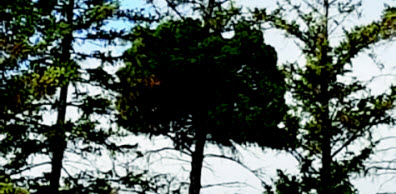According to legend, the habit of a male kissing a female under the mistletoe* started in England among the Druids, who considered mistletoe, cut with a golden knife from oaks (to which mistletoe rarely attaches itself even in Britain), as sacred.
In Norse mythology, Baldur, the god of peace, was slain by an arrow made of mistletoe. He was brought back to life by his fellow gods and mistletoe became sacred to Freya, goddess of love, who decreed that whosoever should pass under it would receive a kiss to show that the plant had ceased to be a symbol of hate. Tradition has it that each time a kiss is planted, a berry should be plucked. When all the berries are gone, the kissing stops.
Mistletoe (Viscum album) was seen in pre-Christian Europe as the symbol of maleness. The berries became attached to fertility and virility, becoming the symbol of romance.
The term mistletoe is said to derive from the Old English words for mistal meaning dung, and tan, meaning twig.
The Latin word viscum means sticky. Mistletoe berries contain a mucilaginous substance that is very adhesive. When a bird tries to eat the berries, which are high in protein, the juice gets stuck on their bills. They try to rub it off on the nearest branch, where the seed adheres then puts down its roots — haustorium — the organ that sends out fibres to penetrate the wood, seeking out the nutrients from the arteries of the tree, upon which the mistletoe lives.
In South Africa, chewed mistletoe berries were once used as “birdlime” to catch birds. The messy mass was spit out and rolled into thin strands of sticky stuff and then wound around a perching branch. When the bird landed on it, it got stuck and was then easy to capture. Incidentally, boiled bark from the holly tree was also used as birdlime.
Mistletoe is an evergreen. It loves to parasitize trees such as apples, ash and hawthorn where it forms great green, leafy balls. A tree infested with mistletoe can look very green in midwinter. Some orchardists take advantage of mistletoe's preference for apple trees, harvesting the fruit in the fall and the mistletoe in December when the berries ripen. The mistletoe is nurtured but controlled and not allowed to destroy its host.
So far, we’ve been speaking about Viscum album, the mistletoe of Europe. Here in North America, we have our own version. Arceuthobium americanum, also known as dwarf mistletoe, can infect evergreen forests of jack pine, black and white spruce, as well as tamarack, and it is prevalent in Manitoba. It looks very different from typical mistletoe with growths that look like yellow coral springing from a tree branch until it gets old enough produce its blue-green fruit. It can promote the growth of witch’s boom.
Dwarf mistletoe doesn’t wait for birds to disperse its seeds, although chickadees and a few others will eat it. It relies for dispersal on a buildup of water and an explosive release. If a seed lands on another tree, it’s party time. Like an alcoholic, this variety sucks sugars from the tree in addition to the water and minerals that the European mistletoe relies upon.
People can become very ill from eating European mistletoe berries and leaves. They cause stomach cramps and diarrhea. However, resourceful indigenous people in North America used some varieties to relieve stomach cramps and diarrhea.
*For obvious reasons, don’t hang mistletoe for workplace Christmas parties, warned the National Federation of Independent Businesses.



